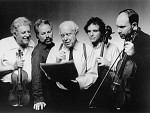Title
The first time I was aware of Elliott Carter I was in college, in the early 1960s, and I went to hear a performance of his Second String Quartet, in which the four instruments are contrasted like different characters in a play. As the piece built up toward the end with a graded series of accelerandi resulting in a furious climax, I was hanging on the edge of my chair. I had no idea music could be like this. It changed my life!
Body
I was fortunate to have had the privilege of working with Elliott on numerous occasions both as an individual and as a member of the Juilliard String Quartet. I was amazed at what an erudite, debonair, humorous, and modest gentleman he could be. When he was reacting to his own music, he was the clearest of any composer I have ever seen in expressing to the performer precisely what he wanted. He would work persistently until the balance, sound quality, and character of what he heard coincided exactly with the idea that had inspired him.
In June 2007, Virgil Blackwell (B.M. ’68, M.S. ’69, clarinet), his personal assistant, unexpectedly handed me a package saying, “Elliott wanted you to have this.” I opened it and found Figment IV for Solo Viola written for and dedicated to me. I was totally overwhelmed by the tremendous generosity he showed both to me and to the viola with this gift. As soon as I learned the piece, I went to play it for him. I will always remember how enthusiastic he was as he half-sang and danced the phrases of the piece to me. He was also so gracious when I began to realize his idea and get closer to what he imagined. As I perform it more and more now, I have come to understand what an important addition it is to the viola repertoire.
In 1991 to celebrate the 45th anniversary of the Juilliard String Quartet, we decided to perform and record the complete Carter quartets. At that time, there were only four; the fifth did not appear until 1995. During this project, Elliott was present at every rehearsal and every recording session directing us, sometimes enjoying what we did and other times agonizing along with us to help us to get closer to portraying his ideas. At one point, as he observed us struggling with one of the many formidable difficulties of rhythm and ensemble, he burst out, “Why does it have to be so difficult?” But Elliott, both we and you know the answer: because, like Bach, Haydn, Beethoven, Verdi, Stravinsky, and Schoenberg, you followed your artistic vision in spite of the emotional cost and regardless of whether or not it brought outside fame and public success. Those of us who dedicate ourselves to the task of developing the necessary technical and rhythmic skills to follow in the footsteps of your vision will be incredibly rewarded with a new perspective on what music can achieve and will look with additional insight into the great classics of the past.





